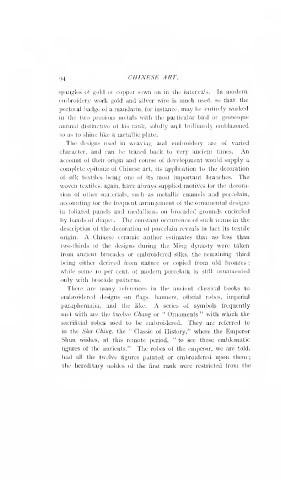Page 328 - Chinese Art, Vol II By Stephen W. Bushell
P. 328
CHINESE ART.
94
spmgles of gold or coppar sewn on in the intervals. In modern
embroidery work gold and silver wire is much used, so that the
pectoral badge of a mandarin, for instance, may be entirely worked
in the two precious metals with the particular bird or grotesque
animal distinctive of his rank, solidly ani brilliantly emblazoned
so as to shine like a metallic plate.
The designs used in weaving and embroidery are of varied
character, and can be traced back to very ancient times. An
account of their origin and course of development would supply a
complete epitome of Chinese art, its application to the decoration
of silk textiles being one of its most important branches. The
woven textiles, again, have always supplied motives for the decora-
tion of other materials, such as metallic enamels and porcelain,
accounting for the frequent arrangement of the ornamental designs
in foliated panels and medallions on brocaded grounds encircled
by bands of diaper. The constant occurrence of such terms in the
description of the decoration of porcelain reveals in fact its textile
origin. A Chinese ceramic author estimates that no less than
two-thirds of the designs during the Ming dynasty were taken
from ancient brocades or embroidered silks, the remaining third
being either derived from nature or copied from old bronzes
;
while some lo per cent, of modern porcelain is still ornamented
only with brocade patterns.
There are many references in the ancient classical books to
embroidered designs on flags, banners, official robes, imperial
paraphernalia, and the like. A series of symbols frequently
met with are the twelve Chang or " Ornaments " with which the
sacrificial robes used to be embroidered. They are referred to
in the Shu Ching, the " Classic of History," where the Emi)eror
Shun wishes, at this remote period, " to see these emblematic
figures of the ancients." The robes of the emperor, we are told,
had all the twelve figures painted or embroidered upon them
;
the hereditary nobles of the first rank were restricted from the

